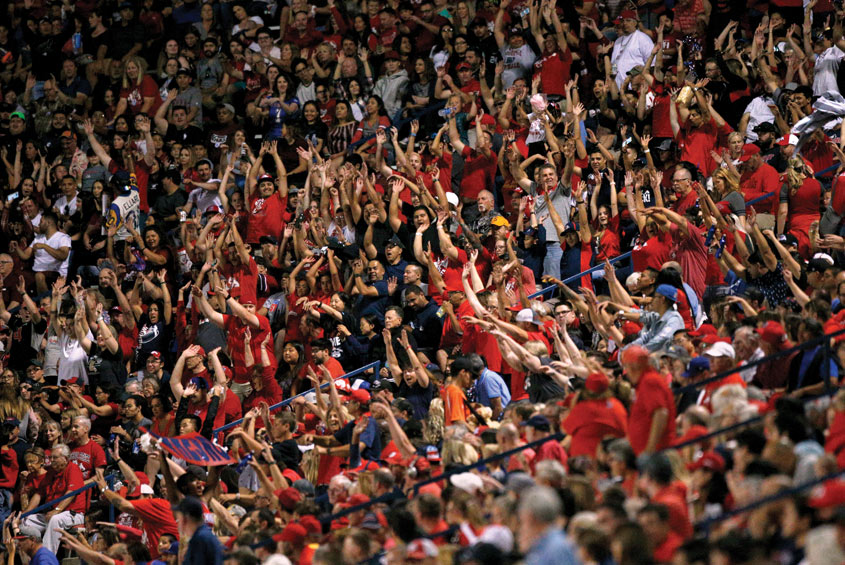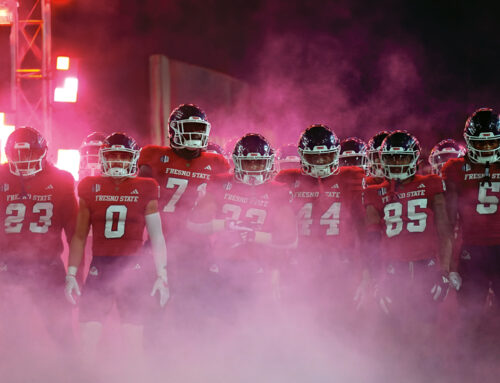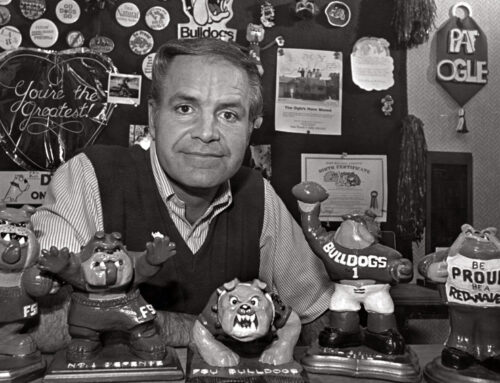ATHLETICS 101:
BULLDOGS RISING
Celebrating 100 years of legacy, with a vision of Fresno State’s future
By Eddie Hughes
One hundred years is worth celebrating. Remembering. Learning. There’s a lot of history bundled up in these pages — some well-known and some that’s surely surprising. The people, the places, the accomplishments — all combining into the milestones that created the pride and tradition that makes Fresno State fans, students and alumni feel so connected to the wins and lessons learned from the losses.
So as we raise our glasses and give cheers to 100 years of Fresno State athletics, we celebrate this moment in time while keeping focused on the future.
In the ever-changing landscape of college athletics, Fresno State has continuously risen to the challenge — oftentimes doing more with less and competing with the best of the best across the country.
From the earliest days of competition in the Roaring ’20s when football and basketball schedules sometimes included high school opponents, to the present day when the Bulldogs’ softball and baseball programs have won Division I national championships, and the football program has claimed wins over the likes of USC, UCLA, Cal, Washington, Wisconsin, Colorado, Virginia, Kansas State and many more.
So what are the athletic department’s priorities as the page turns to the next 100 years? For Director of Athletics Terry Tumey, the top two are improving facilities and continuing to grow resources in order to invest in people.
“We have to invest,” Tumey says. “Our investments need to be very intentional. We must get beyond doing the things that are standard and really make our investments count toward the student experience. We really need to move in that space.”
It’s not lost on Tumey that Fresno State’s sister campuses in the California State University system — and Mountain West Conference rivals — both have major capital projects underway. San Diego State’s 35,000-seat, $310 million Aztec Stadium is scheduled to open in September 2022. San Jose State’s CEFCU Stadium is undergoing a $57 million renovation.
Fresno State, which regularly draws larger crowds than its rival schools, is due for investments in 41-year-old Bulldog Stadium as well, Tumey says. “The stadium is the pinnacle of our athletics department. We want the stadium to be a community asset, so it has to go beyond being used six times a year. Figuring out how to best utilize the stadium where it best serves the community on gameday or for events is definitely on the forefront.”
Fresno State President Saúl Jiménez-Sandoval and University leadership are looking into how to best address stadium improvements, and Tumey is confident the community will step up in support when the time is right.
“We have a community of partners feeling the same way about this University and feeling the same way about athletics, who know what it can be. So I feel very comfortable talking about what we need to move forward.”
Back in the stands
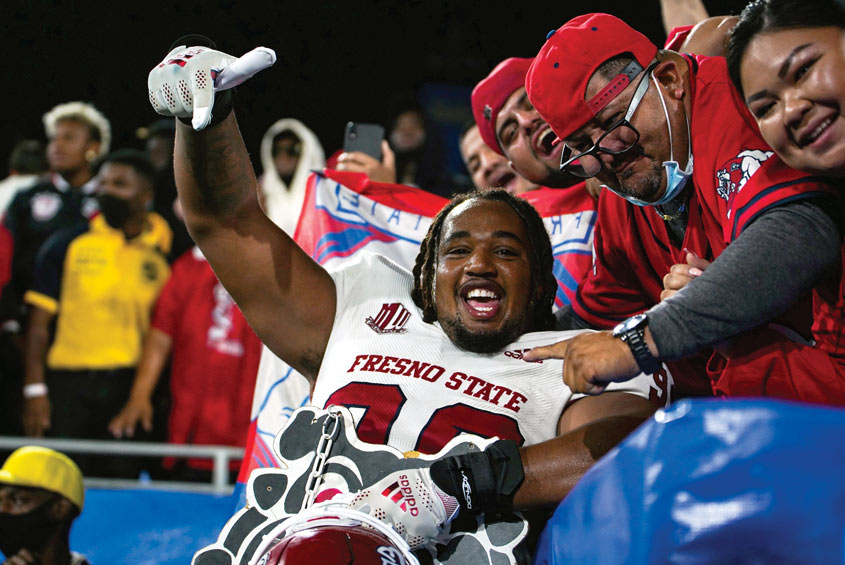
Early in the 2021 season, it was encouraging simply to have fans back in the seats after the pandemic-shortened 2020 season during which no fans were permitted at any of the fall or winter sports competitions.
All-Mountain West football player Kevin Atkins, a defensive tackle, says the team couldn’t wait to play in front of the Red Wave again. “It felt like the first day of school when you’re 5 years old,” Atkins says. “You get excited, get your backpack on, get your lunch and get ready to go.”
He says the team knew people were watching on TV last year, but nothing compares to having fans there in person.
“It’s not the same atmosphere as when you have those people behind you, screaming for you. It’s a different feeling. You get this empowering feeling. It’s like, ‘OK, now I’ve got this city on my back.’”
Pride of the Valley
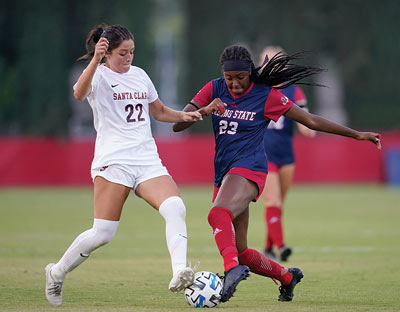
Jordan Brown, a forward on the women’s soccer team, pushes past Alexa Loera, Santa Clara midfielder.
Events like that — whether it’s a football game, softball, volleyball or any other sport — are what creates touchpoints for the community. These events have the power to introduce young people to the University and to higher ed in general, and to inspire them to pursue an education.
“What’s important for us is that athletics truly becomes that portal that allows our University to flourish,” Tumey says. “We’ve had athletic success, and we know what that looks like. We know how Fresno State can move the needle nationally as it relates to athletics. If we continue to drive forward and have success, it continues to shine a light on this great University. We’ll have students who want to be here because they want to be part of a great community.”
That synergy between academic and athletic success is a priority for Jiménez-Sandoval.
“Athletics has the unique power to bring us all together. It’s the most incredible unifier,” Jiménez-Sandoval says. “Just as we intend to build on our widely recognized brand in sports, we also intend to promote and showcase the transformative energy of our academics, the importance of our alumni in the region and the transformative and palpable impact of state investment and private philanthropic support on sustaining and uplifting this most productive Central Valley that feeds the world.”
A unifier. In today’s day and age, perhaps that’s the secret ingredient that makes Fresno State athletics so valuable in the Central Valley.
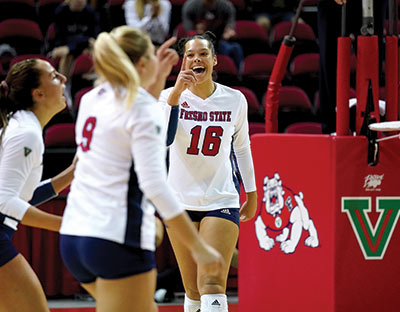
Savanah Smith celebrates with volleyball teammates. Bulldog student-athletes, coaches, and staff proudly wear the “Green V” to show their pride in representing the San Joaquin Valley.
“This university has been a melting pot. It has helped so many people – it doesn’t matter race, color, creed,” says alumnus Lorenzo Neal, a 16-year NFL veteran who had his football jersey retired on Oct. 23. “That’s what’s so neat about sports. It doesn’t matter who you are, where you come from, what your background is. It’s just how you get along, how you coexist. That’s why I think sports has been the basic foundation for this country.”
There is perhaps no other event in the region that brings us all together behind one common cause the way a game at Bulldog Stadium or the Save Mart Center does.
“That’s the beauty of athletics,” Tumey says. “Athletics is the common denominator. It lets everyone in and shares the gifts of the University, no matter where you come from or what your background is.”

